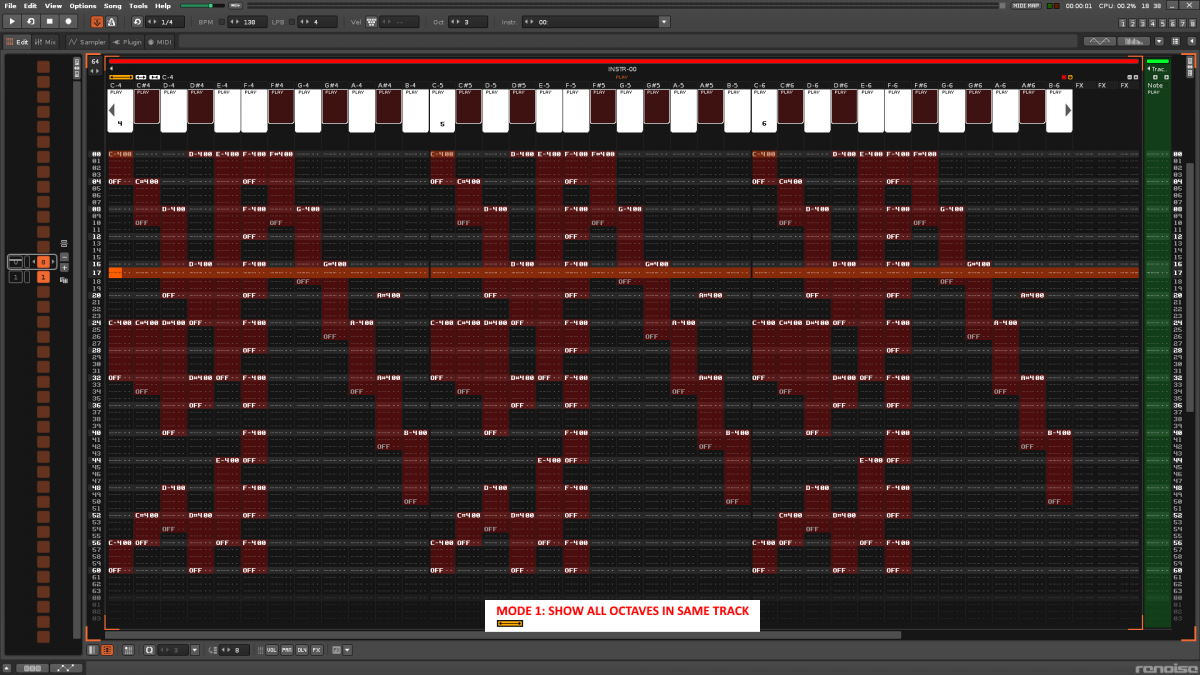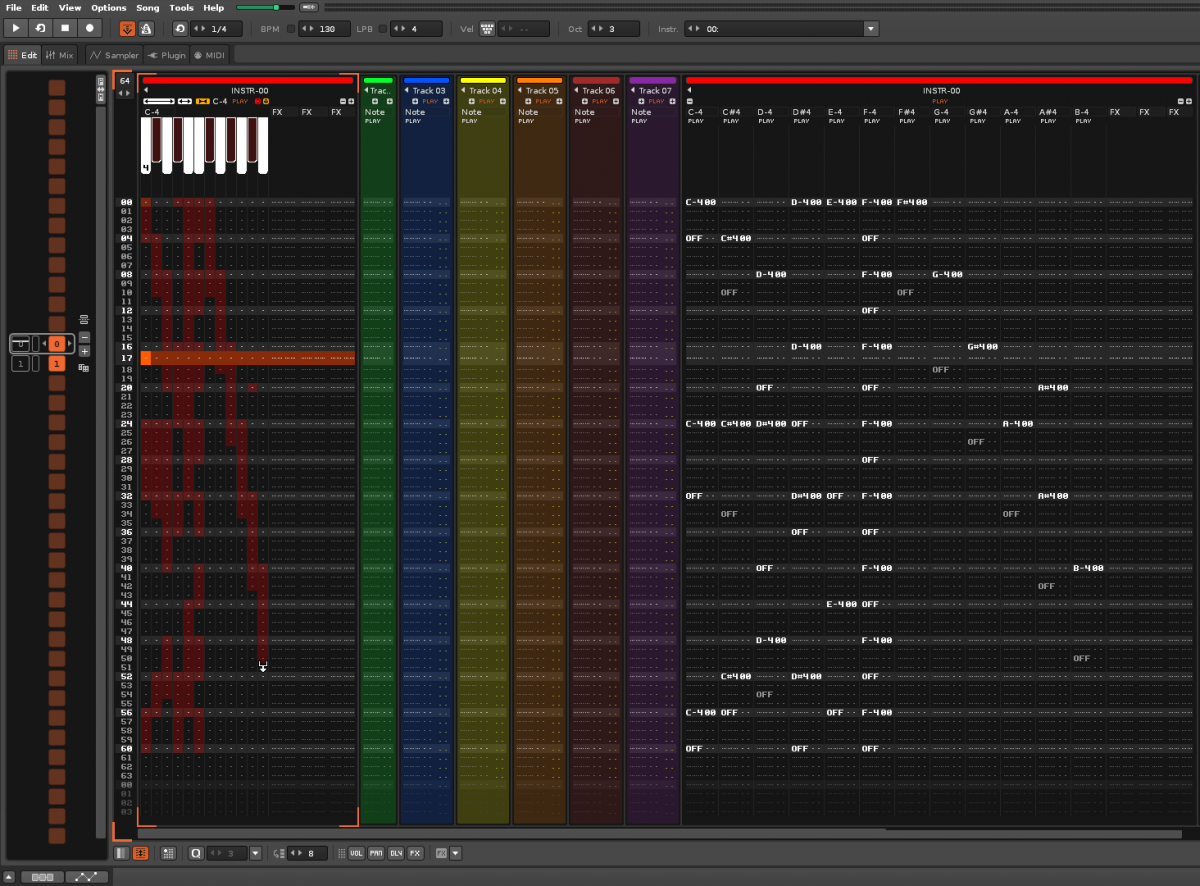Since 2002 there have been many proposals to integrate an Piano Roll.Today, 14 years later,Renoise already have version 3.1and do not have integrated a Piano Roll.I do not need a piano roll. But there are many people upset about this issue.
I’ve been thinking about this topic for over half a year, and I’ve asked myself how to fix it without breaking the essence of Renoise.
Background and premises:
- First birth a piano roll horizontal is a mistake. This idea is excluded.
- Renoise is not yet able to classify the notes.The focus is on the Pattern Editor. “Pattern Editor is silly”.
- Is required an association between track and range of notes of an instrument, referente: the piano. To be complete 10/8 = 120 notes.
- A track have 12 notes.
- Graphic limitations.
- Harnessing of the colors.
With this in mind, there is only one real limitation involves the following capacity:
The pattern editor is able to sort notes in columns.To do so, the focus can be on a single track.Renoise is capable of sounding thousands of tracks.However, each track currently only has 12 columns, which can be associated with 12 notes, 1 octave.
If each track had 120 columns associated with each note, and Renoise is able to sort notes in each column to play live (or not play live), he would be able to support a piano roll.
Renoise currently builds the notes to the left of the track, and use a second or third column to not superimpose notes, in a compact form.With the creation of a function of descompress notes and other notes compaction would be all sorted to create a pianoroll and integrate, and retain all the functions of Renoise, intact.
Therefore, the first objective would be the classification of the notes within a track.
This screenshot shows the classification of notes on a single track, with the capacity of 120 notes.Above, inside the track, a virtual piano is integrated. Each key holds wide the width of each column. Each octave is marked graphically for visual ease.
This " MODE 1"shows at least 3 octaves of notes. All is a track. Each note length is marked with color backgroundThe duration is marked with OFF value.This in essence is already a piano roll. This is possible by taking advantage of the graphical interface.This Mode 1 intends to occupy the entire screen width. The pattern Editor is intelligent.The composer writes a note and the Pattern Editor automatically put into place within the row (a file, 120 notes).
The " MODE 2" is compact. Show only 1 octave (or 12 or 1+12+1 notes).It’s like Mode 1,but leaves room for other tracks within the screen.
The " MODE 3" is a pure Piano Roll.Basically shows graphically the Mode 2 or Mode 1 expanded if desired, but only with vertical rectangles.These boxes represent the beginning and the end of the note, nothing more.With the mouse drag would be possible, and even extend / trim each note.
What is it good for?
You can compose with your piano midi or your keyboard USB. The pattern editor classifies the notes within the track, regardless of the instrument used. Use the Mode 3 forto visually understand how does your musical composition.You can use the mouse to insert notes, drag, and lengthen the duration.
These three modes are activated through a top icon, called " Piano Mode" (In the screenshots it is located up on the left.):
- If the “Piano Mode” is off, Renoise functions as in version 3.1, the Pattern Editor accumulating notes in the same column in a compact manner.
- If the “Piano Mode” is on, the Pattern Editor is intelligent, and sorts the notes in columns, enabling the selected tracks with 120 notes and incorporating the virtual piano.
The " Piano Mode" only need two more functions to be well integrated:
- A button to compact the notes in few columns inside the track.When enabled, the piano mode disappears (corresponds to the operation of version 3.1).
- A button to unpack and sort notes in the 120 columns inside the track.When enabled, the piano mode appears. (it is in line to order and to work with piano roll)
- These buttons can be placed on top of the track.
- Of course, each column within the track in the "Piano Mode"will automatically have written the name of the corresponding note (C0…C-4, C#4, D-4…B-9)
- Do you want to repeat some notes in the same row?No problem,modify the note up on some columns (example 3x C-4: modify C#4 and D-4 to C-4…). Therefore, note the columns can be changed.
- Finally and safety, each track will have a padlock locking. Activated, you can not change anything of the track, only copy.
Finally, the virtual piano in track and the mouse is useful:
- With it you can play the virtual piano with the mouse when the Pattern Editor does not have activated the “Edit Mode”…
- With the Edit Mode activated, the virtual piano write the note with the mouse inside the track, in the corresponding row and in the corresponding note column.
- Besides the right mouse button could be associated to include the OFF value in Pattern Editor (With the left write the note, with the right write the OFF value).
All this will help the beginner to compose people, also to be ordained and to better understand the music.
Contemplate the isolated end result of piano roll.Turn your head 90 degrees to appreciate. 
Enjoy!




